Daily sketching becomes exciting with innovative approaches. Transform ordinary objects by sketching from unusual angles or create micro-ecosystems to document. Travel diaries combine watercolors with ticket stubs for authenticity, while mixed media adds unexpected textures. People-watching develops unique character designs, and micro-sketching reveals overlooked details. Time-limited sessions release creativity under pressure, while emotional environments translate feelings into visual elements. Urban nature hunts and thematic explorations push artistic boundaries further. These approaches reveal hidden artistic talents waiting to be discovered.
Key Takeaways
- Create everyday object transformation sketches by drawing common items from unusual angles or reimagining them as magical elements.
- Develop emotional landscape drawings using colors and lines to visually represent different feelings and internal experiences.
- Practice micro-sketching with fine-tipped pens to capture tiny details often overlooked in subjects like leaf veins or insect wings.
- Implement time-limited drawing sessions (1-5 minutes) to enhance spontaneity and focus on capturing essential forms.
- Combine mixed media by incorporating unexpected materials like pressed flowers, ticket stubs, or textured papers into traditional sketches.
Everyday Objects With an Unexpected Twist
When was the last time you looked at your stapler and imagined it as an ancient dragon? Ordinary items sitting on your desk or shelf can transform into extraordinary art subjects with just a dash of imagination.
That vintage pair of shoes might tell stories of magical journeys, while your morning coffee mug could become a portal to another dimension!
Your ordinary possessions hold extraordinary tales – just waiting for your imagination to unlock their secret worlds.
Artists find that everyday objects gain new life through creative storytelling. Try sketching your house keys as tiny characters with different personalities, or turn that crumpled homework paper into a miniature mountain range.
Looking at familiar things from unusual angles reveals hidden details you’ve never noticed before. A simple glass of water becomes fascinating when you add ripples that form faces, or when you draw it floating in space surrounded by stars!
Nature Study Challenges for Urban Artists
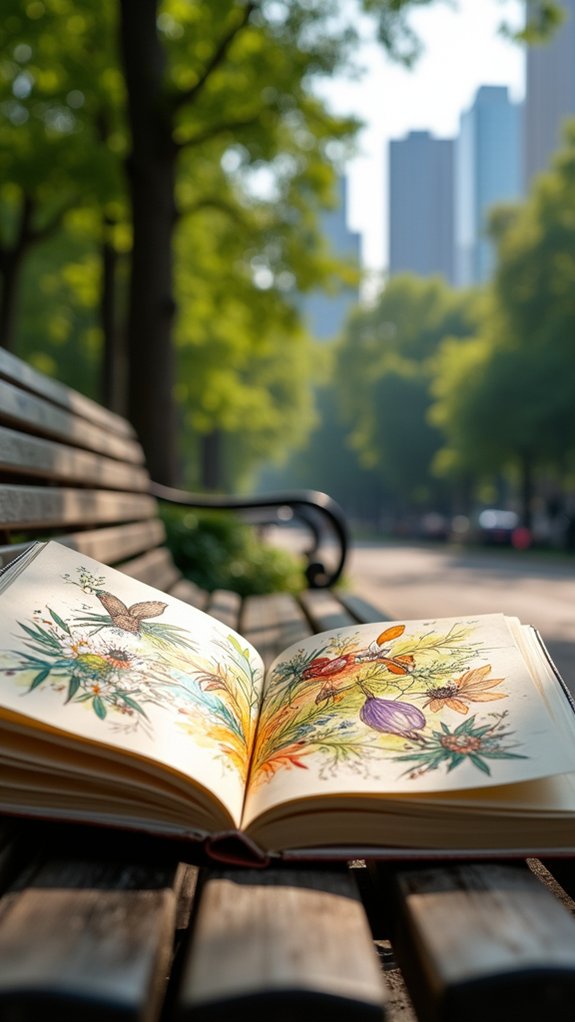
Urban artists can tap into nature through quick foraging expeditions, grabbing fallen leaves, interesting twigs, or unique stones that catch their eye on daily walks.
These collected treasures become perfect subjects for detailed sketches at home, allowing artists to examine nature’s patterns up close without time pressure.
Creating micro-ecosystems in small terrariums or glass jars also provides ever-changing natural subjects to draw, bringing the outdoors inside for artists confined to apartment living.
Quick Urban Foraging
Many artists find themselves yearning for a connection to nature while living in concrete jungles. Urban foraging offers a perfect solution, combining artistic practice with outdoor exploration.
Artists can transform their sketchbook pages into vibrant journals of edible discoveries hiding in plain sight—from dandelions sprouting through sidewalk cracks to berry bushes in forgotten corners of parks.
- Sketch a newly found plant each week, noting its location, edibility, and unique characteristics
- Create quick 5-minute studies of interesting fungi or flowers spotted during lunch breaks
- Develop a color-coding system to mark plants that are edible, medicinal, or purely decorative
- Challenge yourself to fill an entire page with different leaf shapes found within a single city block
This practice turns everyday walks into treasure hunts, making even the grayest cityscapes burst with unexpected life!
Micro-Ecosystems Indoors
Indoor artists craving nature don’t need to venture outside to find inspiration worth sketching! By creating small micro-ecosystems in transparent containers with soil, tiny plants, and decorative rocks, they can bring the natural world right to their drawing table.
Watching these miniature worlds evolve offers endless sketchbook opportunities! Artists can document plant growth, moisture patterns, and the fascinating relationships between different elements. Each day brings something new to capture – maybe a seedling unfurling or condensation forming beautiful patterns on glass.
These self-contained nature studies not only sharpen observational skills but also provide a peaceful retreat from busy urban life.
Sketching from different angles reveals hidden layers and perspectives that might go unnoticed in larger environments. Plus, there’s something magical about creating art from a world you’ve helped nurture!
Sketchbook Travel Diaries: Beyond the Tourist Gaze
When travelers venture beyond the familiar postcard views, a world of authentic experiences awaits in their sketchbooks.
Sketchbook ideas for travel diaries transform ordinary journeys into visual stories that capture moments tourists often miss. Artists can document local architecture, bustling markets, and everyday people through mixed media approaches that bring each page to life.
To create memorable travel diaries:
- Combine watercolor sketches with handwritten notes about conversations with locals
- Add ticket stubs, pressed flowers, or food wrappers alongside drawings
- Create quick gesture drawings of people in motion at cafés or train stations
- Include small maps with highlighted paths of “getting lost” adventures
These visual journals preserve not just what places looked like, but how they felt—capturing sounds, smells, and emotions that photographs alone can’t convey.
Mixed Media Experiments for Traditional Sketchers
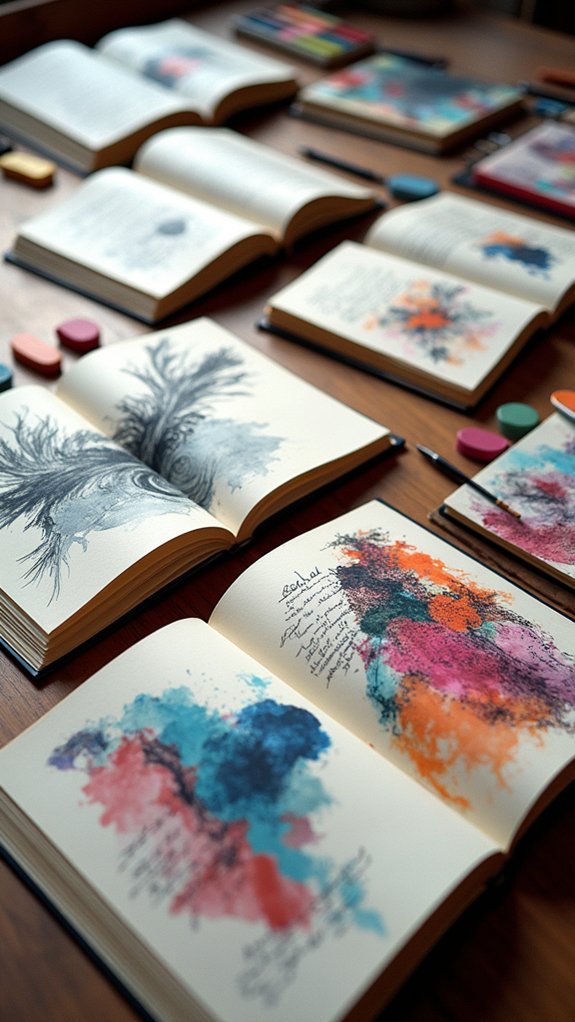
Traditional sketchers can breathe new life into their work by exploring texture beyond pencil, from rough watercolor paper to the bumpy surface created by pressing leaves into wet paint.
Adding unexpected materials—like dried flowers, fabric scraps, or even candy wrappers—creates surprising layers that transform flat drawings into enchanting visual stories.
For artists comfortable with technology, combining hand-drawn elements with digital touches offers exciting possibilities, such as scanning sketches to add digital color or printing digital patterns as backgrounds for hand-drawn figures.
Texture Beyond Pencil
Many traditional sketchers find themselves stuck in a pencil-only rut, missing out on the exciting world of texture that mixed media can offer. Breaking free from this limitation opens up amazing creative possibilities that will make your sketchbook pages pop with excitement and dimension!
Try these texture-boosting techniques:
- Press fabric, leaves, or sand onto adhesive surfaces to create instant textural impressions.
- Layer watercolors with acrylics for surprising depth effects.
- Swap your pencil for weird tools like old credit cards or sponges to make cool patterns.
- Add collage elements—rip up magazines, tickets, or maps to give your sketches a 3D feel.
Don’t forget to jot down notes about your mixed media experiments. These will become your personal texture recipe book for future artistic adventures!
Layer Unexpected Materials
Every artist’s sketchbook becomes a playground for expression once unexpected materials enter the scene! By incorporating items like fabric scraps, newspaper clippings, or textured paper, artists can transform ordinary drawings into multi-dimensional masterpieces.
The magic happens when different elements collide to create unique visual effects that simply can’t be achieved with pencil alone. Try layering watercolors over a collage base, or press actual leaves between pages for natural impressions.
Feeling adventurous? Grab some cotton swabs instead of brushes! When artists mix media, they break free from traditional limitations and discover surprising new techniques.
Three-dimensional elements, like feathers or small packaging bits, add a tactile quality that invites viewers to not just see the art but experience it. Your sketchbook isn’t just for drawing anymore—it’s a laboratory for creative experiments!
Digital-Analog Fusion Techniques
The worlds of pen-to-paper sketching and screen-based art don’t have to stay separate!
Digital-analog fusion techniques offer incredible possibilities for artists who love traditional drawing but want to explore digital enhancements.
These mixed media experiments can transform a simple sketch into something extraordinary, giving artists the best of both artistic worlds.
Try these exciting fusion approaches:
- Sketch by hand, scan it, then add digital colors and textures in layers
- Draw traditionally, then use a tablet to create digital overlays without changing your original
- Print digital designs onto textured paper for that hands-on feel
- Combine printed photos or digital patterns with your hand-drawn elements
This hybrid approach lets you maintain the satisfying scratch of pencil on paper while exploring endless digital possibilities—perfect when you’re stuck in a creative rut!
Character Development Through Daily Observations
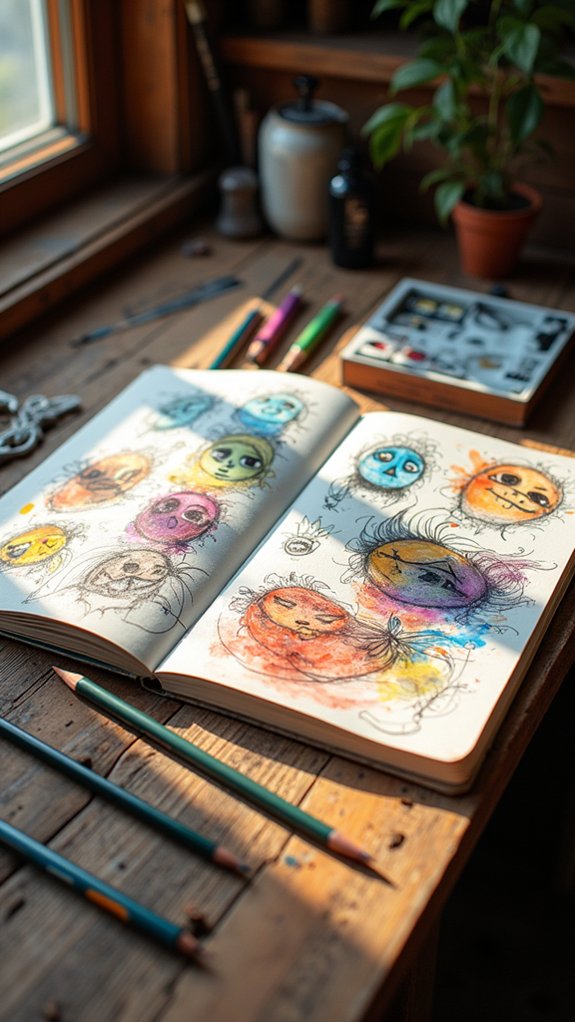
How can simple daily observations transform ordinary sketches into compelling character designs? The magic happens when artists capture authentic expressions, gestures, and personalities they witness in their everyday environment.
A dedicated character sketchbook becomes a treasure trove of human quirks and features, allowing artists to experiment with diverse poses and facial expressions spotted during daily life.
People-watching in cafes, parks, or on public transportation provides endless inspiration for character development. That funny walk from the mail carrier or the unique way a friend laughs might become the defining trait of your next illustrated hero!
Emotional Landscapes: Drawing Your Inner World
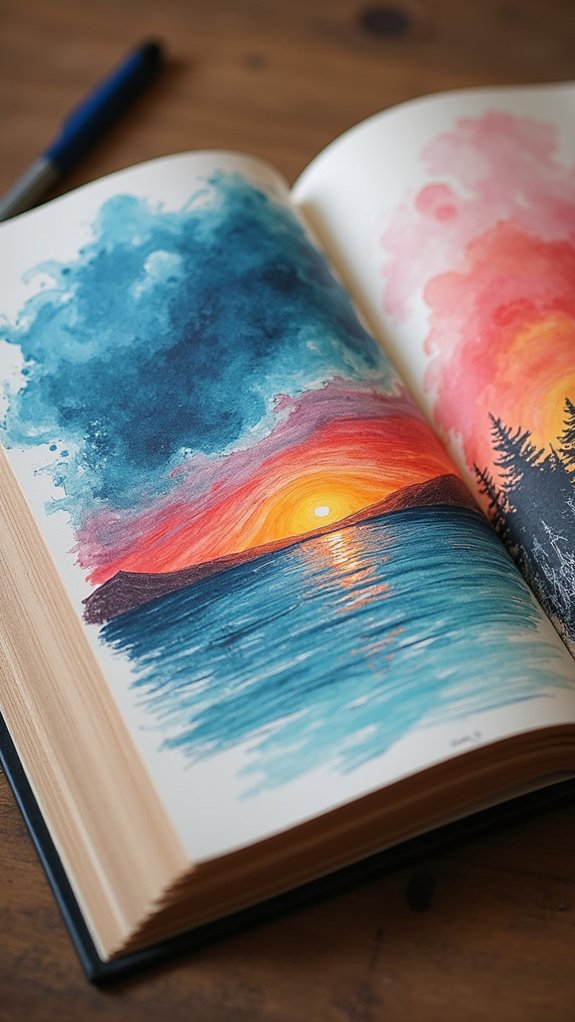
Creativity often begins when artists dare to translate their inner emotional realms onto paper. Emotional vistas offer a unique way to process feelings through art, turning abstract emotions into visual elements that tell stories about our daily life experiences.
By combining colors, shapes, and natural imagery, artists can create powerful visual diaries of their inner worlds.
- Use flowing watercolors to represent calm, peaceful days and sharp, jagged charcoal lines for stressful moments
- Draw mountain ranges that mirror your emotional highs and lows throughout the week
- Create a color-coded system where each emotion gets its own shade (red for anger, blue for sadness)
- Transform daily journal entries into abstract patterns that capture the day’s emotional weather
Micro-Sketching: The Power of Tiny Details
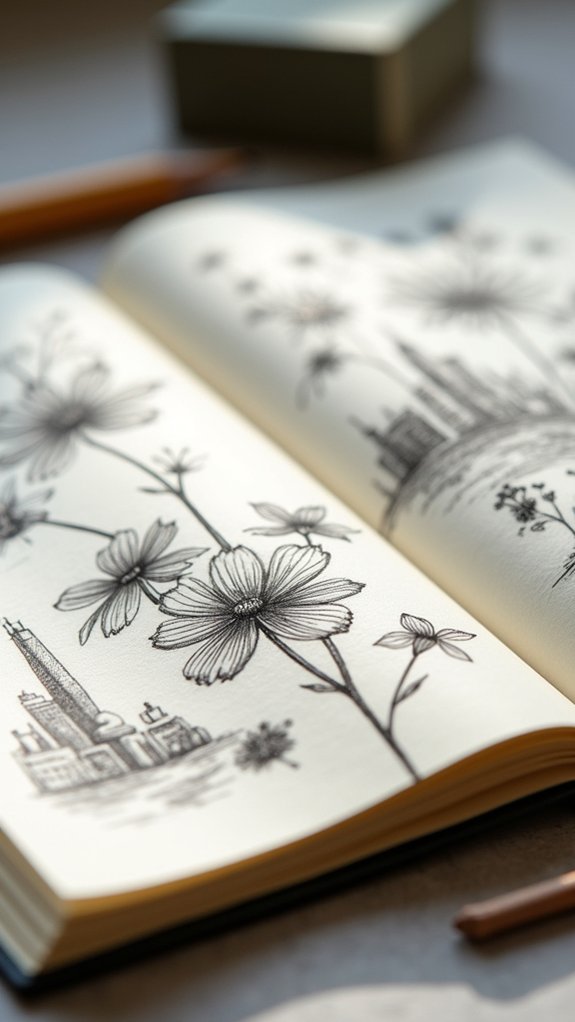
While most artists focus on capturing grand vistas or dramatic scenes, there exists a fascinating world of detail that often goes unnoticed. Micro-sketching invites visual art enthusiasts to zoom in and explore the tiny wonders hiding in plain sight. Using fine-tipped pens or sharp pencils, artists can document intricate textures, patterns, and structures that make everyday objects extraordinary.
| Subject Ideas | Benefits | Tools |
|---|---|---|
| Leaf veins | Improves observation | 0.05mm pens |
| Insect wings | Builds patience | Mechanical pencils |
| Coin details | Enhances precision | Magnifying glass |
This practice isn’t just about making cool, tiny drawings—it’s about training your eyes to truly see! Micro-sketching transforms ordinary sketchbook sessions into mindful explorations that can spark bigger creative projects while teaching you the amazing power of paying attention to life’s smallest details.
Time-Limited Drawing Sessions for Creative Flow
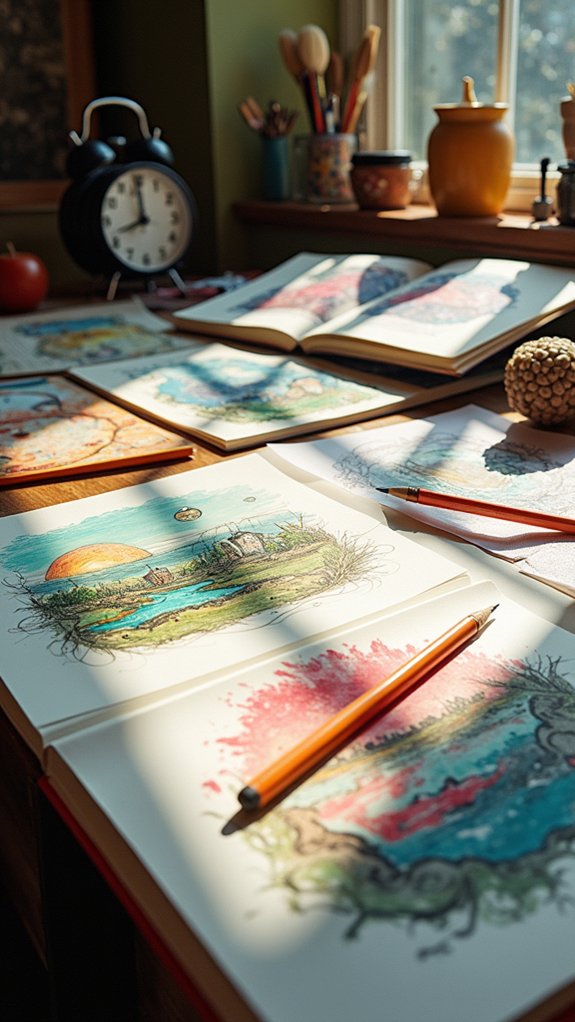
Time-limited drawing sessions can release a river of creativity that many artists never knew they had inside them.
Artists can set timers for rapid gesture captures that force their hands to move before their brains can overthink, or challenge themselves with countdown drawing games where they complete a sketch as the seconds tick away.
Timed observational studies, where an artist might spend just five minutes capturing the essence of a coffee cup or sleeping pet, train the eye to notice what’s truly important in a scene.
Rapid Gesture Captures
Many artists discover that their most authentic work emerges when they don’t have time to overthink. Rapid gesture captures—quick sketches completed in just 1 to 5 minutes—force artists to focus on movement and form rather than getting lost in details.
These time-crunched sessions build amazing observational skills as artists learn to translate what they see onto paper super fast!
Try these four gesture capture exercises:
- Set a 2-minute timer and sketch a family member watching TV.
- Draw your pet in 1-minute intervals as they move around.
- Sketch random household objects for 30 seconds each.
- Try capturing people at a café or park for 3 minutes each.
Using different tools like charcoal or ink adds extra excitement and spontaneity to these quick drawings, making each session a thrilling artistic adventure!
Countdown Drawing Challenges
Building on the concept of quick sketches, countdown drawing challenges take timed artwork to the next level. Artists set specific time limits—anywhere from 5 to 30 minutes—and race against the clock to complete their drawings. This pressure-cooker environment sparks creativity and forces quick decisions, resulting in more spontaneous, energetic artwork!
Looking for ideas to fill your sketchbook? Try drawing objects from memory, designing quirky characters, or illustrating random words within your countdown. The ticking timer creates an exciting urgency that can break through creative blocks and lead to surprisingly expressive results.
Many artists use phone apps or kitchen timers to track their countdowns. Sharing these time-challenged creations on social media connects you with other artists facing the same exhilarating constraints.
Ready, set, draw!
Timed Observational Studies
While countdown challenges test your speed, timed observational studies sharpen your ability to truly see what’s in front of you. Setting a timer forces your brain to focus on what really matters in a subject, boosting your observational skills without getting stuck on tiny details.
It’s like training your artist’s eye to work faster!
Try these timed drawing approaches:
- Start with 5-minute sketches of household objects, then reduce to 2 minutes
- Challenge yourself to draw an old family photo in just 3 minutes
- Sketch the same object three times: 10 minutes, 5 minutes, then 1 minute
- Draw people at a café or park, giving yourself just 30 seconds per person
The magic happens when you stop overthinking and let your instincts take over!
Dream Journal Visualization Techniques

Have you ever woken up from a vivid dream and wished you could capture those fleeting images before they disappear? A dream journal filled with illustrations offers the perfect solution! By sketching the strange environments, bizarre characters, and powerful emotions from your nighttime adventures, you’ll preserve those memories and reveal hidden meanings.
| Dream Element | Sketching Technique | Art Supplies |
|---|---|---|
| Environments | Loose watercolor washes | Watercolor set, brush pen |
| Characters | Quick gesture drawings | Pencil, fine-liner |
| Emotions | Color symbolism | Colored pencils |
| Objects | Detailed line work | Technical pens |
Try different artistic styles to match your dream’s mood—flowing ink for mysterious scenes or bold markers for intense moments. Add written notes beside your drawings to remember important details. Reviewing your illustrated dreams regularly sparks creativity and helps you understand yourself better!
Cross-Cultural Pattern Exploration in Sketching
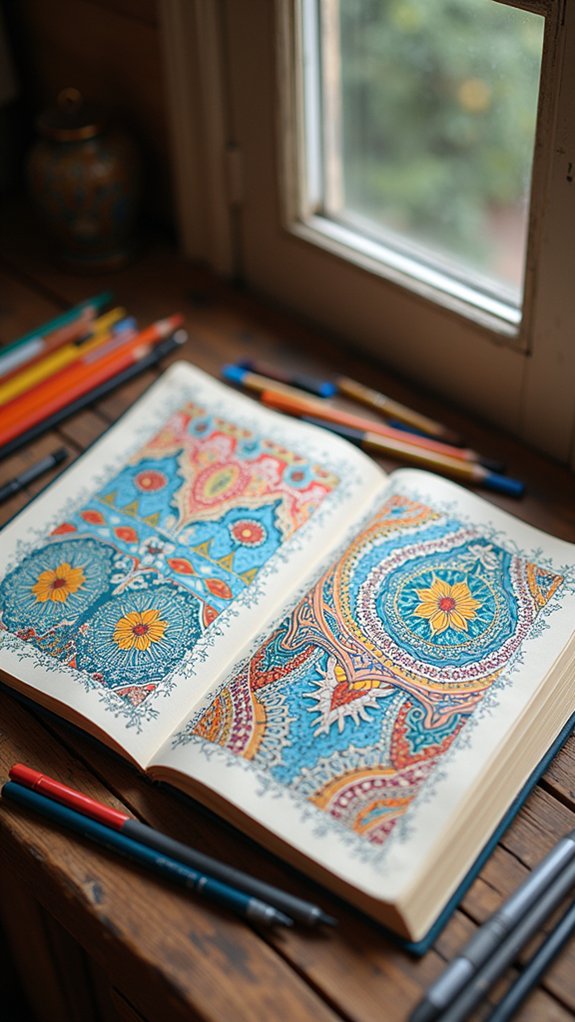
As one explores the vibrant world of cross-cultural pattern exploration, an entire universe of artistic inspiration unfolds from societies across the globe.
Artists can immerse themselves in this colorful ocean of designs, borrowing elements that speak to them while respecting their origins.
Here’s how to begin your cross-cultural pattern journey:
- Study African textiles with their bold, storytelling patterns that practically jump off the page.
- Experiment with intricate geometric patterns from Islamic art that create mind-bending symmetry.
- Try your hand at Japanese motifs that capture nature’s elegance with minimal lines.
- Practice mandala drawing from Hindu and Buddhist traditions for meditative, circular designs.
These approaches not only make your sketchbook pop with excitement but also deepen your appreciation for humanity’s artistic diversity.
It’s like taking a world tour without leaving your drawing table!
Frequently Asked Questions
How Do I Overcome Perfectionism in My Sketchbook Practice?
Artists overcome perfectionism by embracing sketchbook freedom. Setting time limits, creating deliberate “mistakes,” and viewing each page as creative exploration rather than finished art liberates the drawing process.
Can Digital Sketching Complement Traditional Sketchbook Work Effectively?
Digital sketching complements traditional work by providing creative freedom through unlimited experimentation. Digital tools offer advantages like layers and undos while developing different skills that enhance overall artistic growth.
What’s the Best Sketchbook Binding for Left-Handed Artists?
Left-handed artists often prefer spiral binding for its ability to fold completely back. Lay flat binding provides a smooth surface without the spiral’s potential interference with the drawing hand.
How Do Collaborative Sketchbook Exchanges Work Between Artists?
Collaborative sketchbook exchanges involve artist partnerships taking turns with a shared book. Participants often respond to previous entries or follow creative prompts, creating an evolving visual conversation across pages and artistic styles.
What Archival Practices Preserve Sketchbooks for Decades?
Effective sketchbook preservation requires acid-free archival materials, controlled humidity, minimal light exposure, lignin-free storage boxes, and proper handling with gloves. Temperature-regulated environments further extend longevity across decades.
Conclusion
Sketchbooks offer endless possibilities for creative exploration, helping artists break free from boring routines. By trying these unique approaches, anyone can transform their daily drawing practice into an exciting adventure. Remember, there’s no right or wrong way to fill those blank pages—just grab your pencil, let your imagination run wild, and watch your artistic skills grow. The most important thing is to keep drawing, every single day!

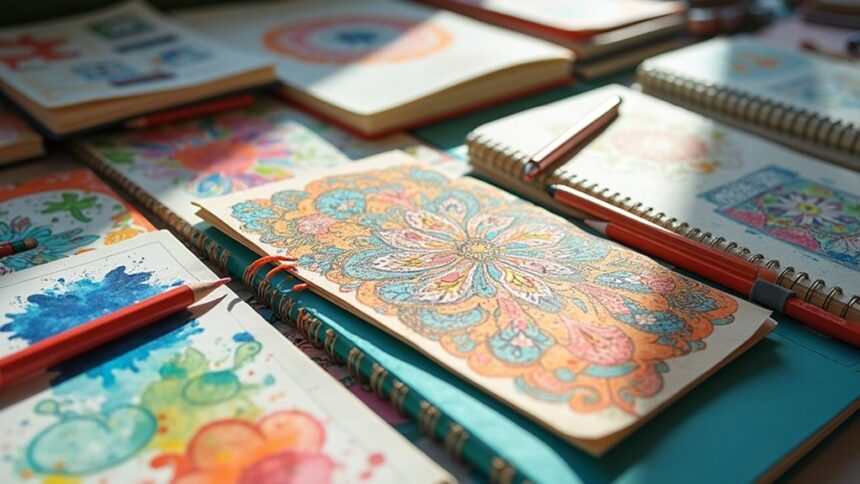
Leave a Reply